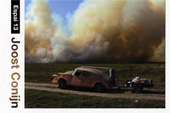- Exhibition program
- Cycle: Obsessions (zero % standard)
- Artist
- Joost Conijn
- Dates
- —
- Curated by
- Montse Badia
The work of Joost Conijn ( Amsterdam, 1971) starts from a fascination with alternative ways of living and cultures different from Western culture. His journeys, often linked to a will to carry out projects that seem totally impossible, trigger unexpected situations, ingenious solutions and enriching exchanges. As the artist himself explains, “an essential element is the face-to-face interaction with the people that I meet along the way”. Making films which bring together all those processes is his way of presenting his projects in the exhibition space. Whilst in his early works the focus was on the construction of vehicles or sundry elements (a plane in Airplane, 2000 or a fence in C’est une Hek, 1997), in the later films it gradually shifted to the people and cultures closest to the basic principles of existence.
The exhibition TWO FILMS presents two of his most recent films, Wood Car and Siddieqa, Firdaus, Abdallah, Soelayman, Moestafa, Hawwa and Dzoel-kifl. Wood Car (2002, video, 32 minutes) shows a journey made in a wood car built by the artist. It operates on the combustion of wood, a method that had already been used in the Second World War. The need to be constantly supplied with fuel determines the route to follow, always near woodland. The journey begins in Holland and continues through Belgium, Germany, the Czech Republic, Rumania, Ukraine, Hungary and Albania, passing through inhospitable places and discovering archaic lifestyles. As Conijn says: “The car makes friends wherever it goes. It turns out that the people here all gather wood to see them through the winter. And when they stop to rest and picnic in the grass among the blossoming fruit trees, they surmount the language barrier by allowing me to share in their bread and home-made cheese”.
Siddieqa, Firdaus, Abdallah, Soelayman, Moestafa, Hawwa and Dzoel-kifl (2003, video, 42 minutes) is the title of the second film and also the name of the seven children of a Dutch family who live according to the rules of Islam and therefore in a way that has nothing to do with Western standards. The family lives in a caravan in a squatters’ area on the wharves of the city. Once again Conijn explains: “The site is bounded by a fence. Outside the fence is a “foreign country”: a marginal zone that doesn’t belong anywhere. This is a place where nomads and tramps live in small huts and caravans. These people are not only cast out by society but are not even tolerated by the squatters. The Islamic family with its seven children lives outside the fence; the youngest is three years old, the eldest is fourteen. They live and play in the rough no man’s land that is in the preparatory stages of being converted into future business premises, less than five kilometres away from Amsterdam, far removed from the conventions of the social manifesto.
It is not the intention of the film to expose illegality or marginality, nor the problems which are associated with this. The film touches on universal concepts such as freedom and authenticity. With spontaneity and inventiveness these children fill their days, despite the isolation and poverty in which they are growing up. What does life hold for these wild children? Will their autonomy result in an exclusion by society, or will they develop in an entirely original way, uninhibited by convention? Will they ultimately be granted a choice between a free life or a conditioned existence?”
Conijn’s films are a perfect compilation of the spontaneity and authenticity of events. They often have no chronological structure but lead us gently through the actions and discoveries. In C’est une Hek, he collects different elements, some from cars, and prospects for the ideal place in the desert, though we as spectators do not know until the film is well under way that the aim of his activity is to construct a fence in the middle of the desert. Airplane takes the spectator through a non-chronological process which ends with a crucial moment, i.e., the flight of the plane built by the artist. Wood Car, on the other hand, does not have a linear structure, but brings us to different scenes from his numerous encounters and abundant knowledge. Siddieqa, Firdaus, Abdallah, Soelayman, Moestafa, Hawwa and Dzoel-kifl is, according to Conijn, “made like a nature film: waiting in an alert and patient way for something to happen. The subject indicates when it has said enough about itself, what the structure will be, and when the film is finished”.
Montse Badia
November 2004
Special thanks to Jellichje Reijnders


